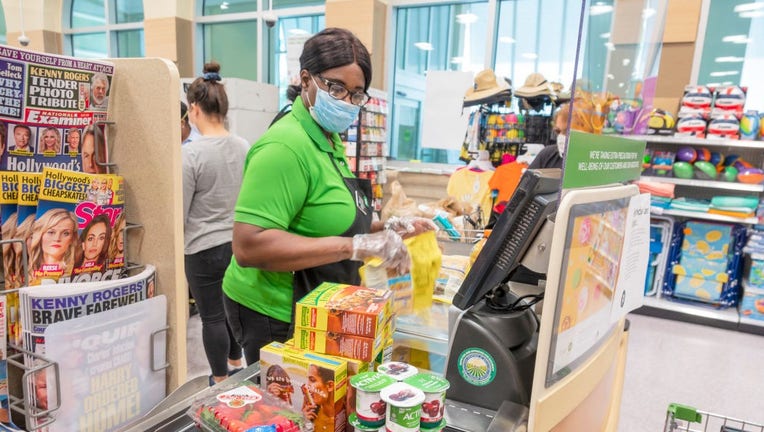Report: People of color disproportionately working essential frontline jobs

Miami Beach, Publix grocery store, cashier wearing face mask, gloves and new plexiglass shield protection. (Photo by: Jeffrey Greenberg/Education Images/Universal Images Group via Getty Images)
OAKLAND, Calif. - The Bay Area's essential workforce is disproportionately composed of some of the region's most disadvantaged groups who are being put at greater risk during the coronavirus pandemic due to the nature of their jobs and their socio-economic realities, according to a new study by the Bay Area Equity Atlas.
Over the past two months, since the region has been on strict
lockdown to help slow the spread of the virus, only work deemed essential has been allowed to continue.
While large segments of the economy are completely or
significantly closed, grocery store employees, farmworkers, public transit drivers, construction workers, janitors, health care workers, delivery drivers and similar frontline workers have been expected to carry on.

FILE -Medical workers stand outside NYU Langone Health hospital as people applaud to show their gratitude to medical staff and essential workers during the coronavirus pandemic on April 29, 2020 in New York City. (Photo by Noam Galai/Getty Images)
Many of these jobs require people to forego the social distancing
practices the rest of the population is asked to adopt, making them hazardous occupations in the time of COVID-19.
And all of these jobs are being done disproportionately by
Latinos, African Americans, Filipinos, women of color and immigrants.
"The analysis really brings to light the existing economic and
social inequities of the essential workforce and underscores the need to protect the health and safety of these workers and ensure that they are appropriately compensated," said PolicyLink Senior Associate Jamila Henderson, one of the report's authors.
The report notes that the Bay Area's 1.1 million essential workers
-- who make up 28 percent of the region's overall workforce -- are more likely to live in or near poverty, rent rather than own their homes, pay too much for housing, have limited English proficiency and lack U.S. citizenship, among other things.
Also, 58 percent of Bay Area workers are people of color, but
account for 66 percent of the essential workforce, according to the report.
Latinos, who make up 22 percent of the workforce, account for 31
percent of all essential workers, 67 percent of workers in building, cleaning and waste management jobs and 63 percent of workers in agricultural jobs.
And while black workers represent 5 percent of the region's
workforce and hold 6 percent of essential jobs, they account for 23 percent of public transit workers, the report says.
"They are at greater risk to contracting the virus and of course
more vulnerable to the economic impacts," Henderson said.
The reports authors call on employers and federal, state and local
governments to provide safe working conditions, offer paid sick leave, hazard pay and living wages and to allow workers to form unions.
"If we're not going to provide those things, people should be
getting supplemental payments to help with rent and other payments," Henderson said.
While some local governments have implemented eviction moratoriums and mandatory sick pay, for example, and the state has forbid water and power shut-offs over bill delinquencies, there has been no comprehensive, universal effort to protect the essential workforce.
"No jurisdiction has canceled rent, mortgages or utilities and
it's a little scary to think about what the future could look like,
especially seeing some of those unemployment projections," she said.
The report is based on Census Bureau data gathered by the Center for Economic and Policy Research.
The Bay Area Equity Atlas is a website repository of statistical data and analysis focused on the issues of inequity and is produced in
partnership with the San Francisco Foundation, PolicyLink and the University of Southern California Program for Environmental and Regional Equity.
The study can be found here: https://bayareaequityatlas.org/essential-workers.

